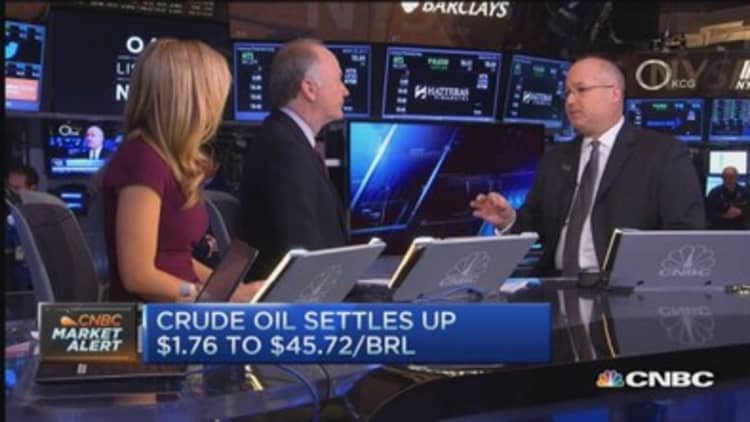
Fine-tuning a near-retirement investment portfolio can be tricky. Yields—even amid a recent rally and expectations for an eventual Fed hike—remain at historically low levels, and growth stocks can be fickle.
Enter multi-asset exchange-traded funds (ETFs). The advantage of ETFs, say experts, is a structure that allows the manager to diversify among more asset classes, including high-yield areas such as master limited partnerships and real estate investment trusts.
By customizing portfolios to balance income and growth, multi-asset ETFs can offer investors allocations that fit more snugly as retirement looms. Some multi-asset ETFs offer 5 percent-plus yields.
"Most investors are better off choosing multi-asset ETFs over individual stocks," said David Blanchett, head of retirement research at Morningstar. "It's very hard to build a portfolio without investment knowledge. So professionally managed funds that are diversified are better places to be."
Some multi-asset ETFs also include commodities, like gold. "And they're becoming increasingly diversified," Blanchett said. "So they can do many different things, including offering income."
Paul Britt, senior analyst with FactSet Research Systems, said these ETFs make sense as a way to diversify for investors looking for yield. More yield often means more risk, and the appeal of these ETFs is to avoid putting all your eggs in one basket, such as junk bonds, REITs or MLPs. "All dividend-payers will still have some rate sensitivity, but you might get less sector risk, for example, as opposed to getting yield via all MLPs."
Rising rates can be a headwind for MLPs and REITs, which rely on borrowing funds—higher rates mean they will have higher expenses and increases the hurdle rate for taking on new projects. Higher interest rates also mean that the yields on these investments are less attractive relative to bonds.
Is this too risky for near-term folks who need a steady income stream and capital protection? Maybe, but show me the alternative that provides that right now.Paul BrittSenior analyst at FactSet Research Systems
In a sense, the multi-asset ETFs are the latest attempt by ETF sponsors to appeal to investors who, nearing retirement, have flocked to target-date funds in order to shift their asset allocation to higher-income, lower-risk investments. The same logic in favor of target-date portfolios—that investors are not good at asset allocation or trying to time the market—applies to multi-asset ETFs.
The difference is that the ETF industry took a crack at target-date ETFs in recent years, but most of them flopped. "There was little adoption," Blanchett said, so several of the target-date ETFs have been closed.
Multi-asset ETFs, on the other hand, now number in the dozens and keep multiplying. Assets in these ETFs have grown from less than $500 million in 2010 to more than $6 billion today. Net flows into these ETFs on an annual basis hit their highest level in 2014, at over $1.8 billion. Flows remained positive in the first quarter this year, near $500 million, according to FactSet Research Systems.
Why the divergent fortunes between target date ETFs and multi-asset ETFs?
Read MoreETF adoption crosses a huge hurdle
Britt said these ETFs could be construed as the "in-target" fund or the far right part of the glide path—that's the term used for target-date funds as they move from higher risk to lower risk as an individual ages. But Britt said the real appeal is simply off-the-shelf diversified yield.
Robert Leahy, a certified financial planner in New York, said he uses multi-asset ETFs because they are diversified and very simple and easy to monitor.
David Fabian, a managing partner at FMD Capital Management, uses the First Trust Multi-Asset Diversified Income ETF. It's the biggest among the new breed of multi-asset ETFs, with more than $1 billion in assets. Its 126 holdings are spread out among five different investments, including high-yield corporate bond ETFs and MLPs. And it has an enticing 6.26 percent yield. It has a net expense ratio of 67 basis points.
Yield to common sense
Some multi-asset ETFs focus more sharply on income than others. The Guggenheim Multi-Asset Income ETF, the second-biggest multi-asset ETF, with $838 million in assets, is spread among 149 securities that include exposure to preferred stocks, MLPs and closed-end funds. It has a 6.18 percent yield. It has a net expense ratio of 84 basis points.
Multi-asset ETFS can pump up yields, but holdings such as MLPs and mortgage REITs are more risky than typical yield instruments, said Mitch Tuchman, a money manager at Rebalance IRA. But he said the lack of asset-allocation knowledge among investors makes the multi-asset ETFs worth considering.
Fabian said higher yields doesn't just mean higher risk but greater volatility. Holding lots of bonds also means that a fund may underperform in a bull market, Fabian added. He advises investors to build a portfolio beyond just one ETF—even one multi-asset fund.
Read MoreAdvisors choosing ETFs over mutual funds for first time
The Guggenheim Multi-Asset Income ETF, for example, has 36 percent of its holdings in financials and 22 percent in energy. The First Trust Multi-Asset Diversified Income Fund has its portfolio split into five buckets of roughly 20 percent each: high-yield corporate issues, MLPs, REITS, dividend-paying equities and preferred securities.
Britt agreed that there is plenty of risk in these ETFs and still less diversification versus a typical equity portfolio, but that's typically going to be the case when the primary focus is yield. He summed it up this way: "Is this too risky for near-term folks who need a steady income stream and capital protection? Maybe, but show me the alternative that provides that right now."
Most of the multi-asset ETFs are relatively new, so they don't have long performance histories, said Ron Delegge, founder of ETFguide. However, DeLegge agreed that since a portfolio can't be fully diversified without owing real estate and commodities, these ETFs raise awareness about a key asset-allocation issue.
As multi-asset ETFs keep gaining traction, understanding what you're buying will become even more important, Blanchett said. Some multi-asset ETFs, for example, have fewer than $100 million in assets and may not be as liquid as bigger ones. Others may own aggressive holdings that don't fit more conservative income needs near retirement.
"Spend some time looking," Blanchett said. "And don't just look at the highest performers."
"These products are far from homogeneous," Britt said.
Multi-asset ETFs
| Fund Name | Expense Ratio |
| AdvisorShares Pring Turner Business Cycle | 1.68% |
| AdvisorShares YieldPro | 1.51% |
| Arrow Dow Jones Global Yield | 0.75% |
| Arrow DWA Tactical | 1.52% |
| Cambria Global Momentum | 0.94% |
| Claymore CEF -Linked GS Connect ETN | 0.95% |
| ETRACS Diversified High Income ETN | 0.84% |
| ETRACS S&P 500 Gold Hedged ETN | 0.85% |
| First Trust International Multi-Asset Diversified Income | 0.79% |
| First Trust Multi-Asset Diversified Income | 0.67% |
| First Trust Strategic Income | 0.90% |
| Global X | JPMorgan Efficiente | 0.90% |
| Global X Permanent | 0.49% |
| Guggenheim International Multi-Asset Income | 0.81% |
| Guggenheim Multi-Asset Income | 0.84% |
| iShares Aggressive Allocation | 0.23% |
| iShares Commodities Select Strategy | 0.48% |
| iShares Conservative Allocation | 0.25% |
| iShares Growth Allocation | 0.24% |
| iShares Moderate Allocation | 0.24% |
| iShares Morningstar Multi-Asset Income | 0.60% |
| Master Income | 0.87% |
| PowerShares CEF Income Composite | 1.88% |
| SPDR SSgA Global Allocation | 0.35% |
| SPDR SSgA Income Allocation | 0.70% |
| Tuttle Tactical Management U.S. Core | 1.34% |
| WBI Tactical High Income Shares | 1.08% |
| WBI Tactical Income Shares | 1.05% |
| YieldShares High Income | 1.66% |
| (Source: FactSet Research Systems) |
—By Constance Gustke, special to CNBC.com




